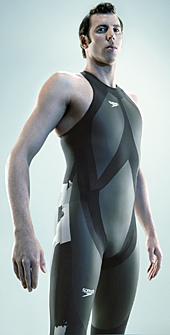AMES, Iowa -- When Speedo unveiled its new LZR RACER® swimsuit Tuesday (Feb. 12) during a news conference in New York City, many of the world's greatest swimmers were there to endorse it. Among them were "Team Speedo's" world record holders Michael Phelps, Natalie Coughlin, Kate Ziegler and Katie Hoff.
Rick Sharp, a professor of exercise physiology in Iowa State University 's kinesiology department, was also in the front row and one of the first people introduced as "a distinguished contributor" when the suit was unveiled. That's because Sharp played a key role in the design team that created the new suit. It is expected to be worn by most United States swimmers and swimmers from more than 50 countries at the Beijing Olympics in August (08-08-08). He was seated right next to Bob Bowman, Phelps' coach.
The director of ISU's kinesiology laboratories, Sharp was first asked nearly three years ago by Speedo officials to assist in the design and evaluation of its new competitive suits. He did research and development on Speedo's Fastskin FS-PRO® swimsuit last summer, which used a new, water-repellent fabric made through weaving a combination of spandex and nylon yarn. The fabric feels like a windbreaker when dry and is patented and dubbed LZR Pulse. It weighs 70 percent less than other swimsuits, but has 15 percent better compression -- an important feature in maintaining the pace of world class swimmers.
Taking Speedo design to a new level
The LZR RACER takes that new design to a new level.
"This suit uses the same basic fabric that's in the Fastskin FS-PRO, but we've added laminated panels over the top, a core stabilizer, and ultrasonically welded seams to reduce drag," Sharp said. "The laminated panels look like a shiny film over certain parts of the body that have the highest drag -- an ultra-low drag film to reduce drag over protruding body parts. That's the main difference in this suit. By adding those panels, it creates further reduction in drag resistance by increasing compression on the fleshiest parts of the body to help maintain a streamlined body shape in the water."
According to Sharp, the core stabilizer is an extra layer of material around the hips and waist that provides extra support to the swimmer in aligning the body to maintain streamlined body position throughout the race.
"Using bonded seams reduces the profile of the seam so water can flow more easily across the seam -- producing less drag," he said.
The Speedo LZR RACER has 10 percent less passive drag than Speedo's FASTSKIN FSII launched in 2004, and 5 percent less passive drag than the FS-PRO.
"In theory that should pay off in improved performance," he said.
Researching swimsuit design for 10 years
The ISU researcher has done research during the last 10 years on suit design and swimming performance. He did a previous study on the early version of whole body suits to see if it produced any performance advantages.
With Speedo, he's analyzed the physiological data that's come in from testing all over the world and made suggestions on improving performance. The design team has also used data gained from body scanning hundreds of international swimmers.
Many of those swimmers were in the room near Sharp during Tuesday's news conference, making it a memorable day.
"It was pretty fun, particularly to be in the room with world-class swimmers and coaches because the suit's success comes down to the people who are going to use it," he said. "And they are all very excited to try it out. That is very gratifying because they all believe the best efforts have been made on their suit design as they head into the Olympics."
Sharp will continue to assist Speedo in design of its future competitive swimsuits.
"Project London (site of the 2012 Summer Olympic Games) starts today," he said.
An archived webcast of Tuesday's launch of the LZR Racer is available through Speedo's official Web site for the suit at http://www.speedo80.com/.
